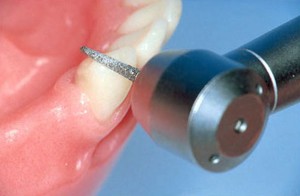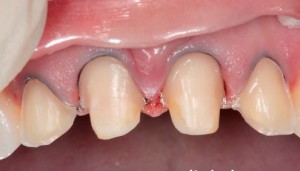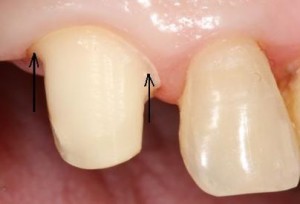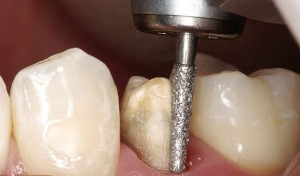Grinding teeth under crowns

Grinding teeth under crowns is one of the requirements for dental prosthetics.
This is necessary in order for the construction to sit accurately and be invisible.
After the oral cavity is completely ready for prosthetics with crowns, the tooth is honed.
- A dentist with a set of diamond burs with a drill gives the tooth a special shape.
- Turning is performed using anesthesia, since the process is quite painful.
When turning a dead tooth, anesthesia may be required if this is necessary, for example, if it is necessary to move the gum from the tooth by laying a special thread between them in order to form a ledge.
Tooth turning can be done in different ways and its feature depends on the type of crown installed.
- If the crown is made of non-metal ceramics, then the removal of hard tooth tissues is carried out to a depth of 1-2 mm.
- To install a ceramic crown, teeth are not depulpable.
- When fixing a cermet crown, teeth grind more strongly, and nerve removal is recommended.
In the process of turning the tooth, a ledge is formed, the width of which corresponds to the thickness of the tooth crown.
The finished crown is fixed on the turned tooth with a ledge, which allows you to save the contours and dimensions of the tooth.
At the same time, the gum does not perceive the crown as a foreign body and fits snugly to it, which guarantees the absence of problems with the gums in the future.
Thus, after the preparation and turning of the tooth, a “stump” remains, on which the crown will subsequently be fixed.
Why grind your teeth

In the manufacture of the crown, to determine the future edge of the tooth, the dental technician focuses on the ledge.
The dentist can place the ledge where it considers necessary, for example, above the gum or at its level.
The finished crown will never be longer than the planned option.
Since the natural shape of the tooth is not ideal, and the teeth are convex, it is impossible to create a crown on such a tooth so that it fits against it with maximum accuracy.
- When grinding a tooth, they give it the correct shape, on which the crown can be easily fixed.
- In addition, the design itself has a certain thickness, which is taken into account when turning so that the crown does not cause a state of discomfort when talking and eating.
- When grinding a tooth surface, all tissues affected by caries are removed to prevent secondary infection and tooth decay under the crown.
Do they always make a ledge
Dentists do not always grind a tooth with a step for the following reasons:
- Tooth preparation without a step reduces the turning time.
- To create a ledge requires special materials and the availability of skills to work with them.If the doctor is used to working with metal crowns, for fixing which there is no need to make a ledge, it is difficult for him to apply the new turning technology. To grind a tooth with a step, a special floss is required, which is laid between the gum and the tooth. It is necessary to protect the gum from injury by boron and to mark the boundaries of the ledge. For the correct positioning of the thread, certain tools are required, which not all dentists have.
- Requires the availability of expensive material for the manufacture of casts, which with great accuracy imprints the ledge.
- A special type of ceramic mass is needed, from which the “shoulder” is made.
- Need a highly qualified specialist in working with ceramics.
It should be noted that it is possible to install crowns on teeth turned without a ledge, and a design made and fixed professionally will have an aesthetic appearance.
But, it is important to know that with such an installation, the tooth under the crown will gradually decay, which can provoke gum inflammation.
Types of ledges
There are several ways to grind a tooth with a ledge:

- Rounded grooved ledge - a classic option for prosthetics with metal ceramics. Its width is from 0.8 to 1.2 mm, which allows you to save the most hard tooth tissue.
- A knife-shaped ledge is the best option for turning under solid cast metal crowns and with inclined teeth. The width of the ledge is 0.3-0.4 mm.
- The shoulder ledge, whose width is 2 mm, is the most uneconomical and requires the removal of a nerve. But this method of turning is the most aesthetic and allows you to firmly fix the structure.
The absence of a step in the process of preparing the tooth is an unacceptable mistake for the dentist, since such a crown cannot fit snugly on the tooth surface, which will increase the risk of secondary caries and complicate the maintenance of the structure.
How to turn
During the preparation of dead teeth, anesthesia for the procedure is not required, except when it is necessary to use dental floss to form a ledge.
- The preparation of live teeth is carried out with the mandatory use of anesthesia.
- Before sharpening a tooth, an X-ray examination of the patient's teeth and bones is required.
Video: “Preparation with a ledge for a ceramic crown”
Grinding teeth for various types of crowns
- Under solid metal crowns, the tooth begins to grind from the side surfaces in order to prevent injury to adjacent teeth. 0.3 mm of hard tissue is evenly removed from the tooth surface.
- When installing cermets, a nerve is removed first, then 2 mm of tooth tissue is ground on all sides of the tooth. In conclusion, a step is formed, the width of which depends on the selected crown model. The walls of the stump of the tooth for reliable fixation of the structure should have a pronounced roughness.
- If the tooth is prepared under a porcelain design, the stump should have a cylindrical or conical shape. Then a rounded ledge is formed, which should be immersed in the gum to a depth of 1 mm. On the palatal surface, a ledge can form on the border with the gum.
- When turning a tooth under a zirconium crown, a rounded or shoulder ledge is formed. The thickness of the grinding of tooth tissues on the front teeth should be no more than 0.3 mm, on the teeth of the chewing group - not more than 0.6 mm.
Grinding Methods
There are several methods for preparing teeth.
Ultrasonic Turning
The preparation is carried out under the influence of ultrasound.
This turning method has the following advantages:
- There is no overheating of enamel, dentin and pulp tissue, since a small amount of heat is generated during operation.
- Painless procedure.
- Working tips practically do not exert pressure on tooth tissue.
- The absence of chips, as well as microcracks on the walls of the pin structures.
Laser turning
To prepare the teeth, a pulsed laser is used, the effect of which is that under the influence of the laser beam in the dental tissues there is a strong heating of water, which evaporates leading to a violation of the integrity of hard tissues, the particles of which are immediately cooled and then removed.
Advantages of laser tooth preparation:

- Painless procedure.
- Silent operation of the laser system.
- High speed procedure.
- There is no risk of infection, as the procedure is non-contact.
- Do not warm the tooth tissue.
- Lack of cracks and chips of pins.
- Safety procedures.
Tunnel Grinding
Currently, modern turbine plants are used, equipped with an adjustment of the turning speed and a set of diamond and metal tips.
The quality of the equipment affects the result of the work, as worn tools can cause overheating of tissues, which will subsequently lead to tooth decay.
In the process of turning a tooth with a tunneling method, they strive to leave as much dental tissue as possible.
The main advantage of the technique is the presence of control over the number of removable tissues and a clear forecast of the result.
The disadvantages of the method include:

- Possibility of soft tissue injury if the preparation technique is broken.
- The presence of a risk of overheating of tooth tissues during turning and severe pain with inadequate anesthesia.
- The formation of cracks and chips of dental tissue when using low-quality instruments.
Air Abrasive Turning
Grinding is carried out using an air mixture with abrasive powder. It is fed under high pressure and when it enters tooth enamel and dentin causes tissue destruction with the removal of dental dust.
Advantages of the method:
- The simplicity of the technique of the procedure.
- High turning speed.
- Lack of pain and overheating of tissues.
- Lack of vibration.
- The ability to maintain the maximum amount of dental tissue.
Chemical Turning Method
For preparation, acids are most often used, which contribute to the softening and destruction of tooth enamel and dentin, followed by removal.
The disadvantage of this method is the need for prolonged exposure to active substances.
The advantages of the technique include:
- Lack of overheating of tooth tissues.
- The procedure does not require anesthesia.
- The absence of cracks and micro-chips on the enamel.
- No sound working drill, which is more comfortable for the patient.
If after grinding the teeth under the crowns, the teeth hurt
During the tooth grinding procedure, local anesthesia is performed. After the effect of anesthesia is over, soreness can occur in the tooth itself or in the gum.
The causes of pain can be as follows:
- During the preparation of a living tooth, too thin a layer of tissue was left above the pulp. As a result, a sharpened tooth reacts painfully to touch and eating, especially cold and sour.
- When a step is formed in the process of laying the dental floss between the tooth and gum, as a result of compression of the soft tissues, pain and swelling may appear.
- The development of pulpitis or periodontitis.
What to do:
- If a thin layer of tissue is left during the preparation, then fixation of a temporary denture to the stump or cementing of a thinned tooth portion is indicated.
- If the pain appeared as a result of soft tissue compression, then this should not be scared. Unpleasant sensations will disappear on their own within 1-2 days.
- If a lot of time has passed after grinding the tooth, you should immediately consult a dentist.